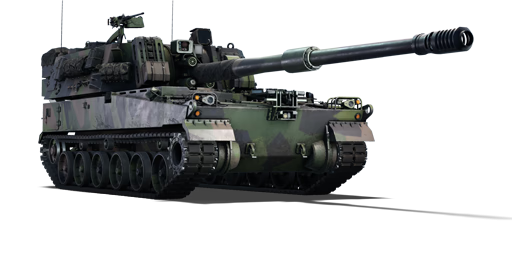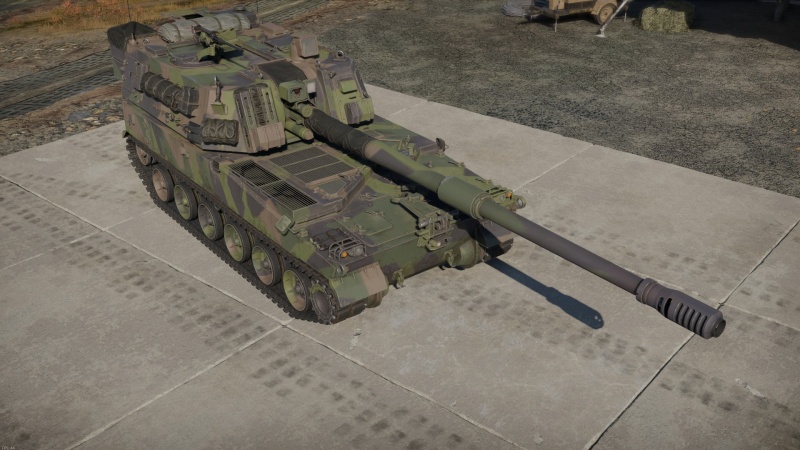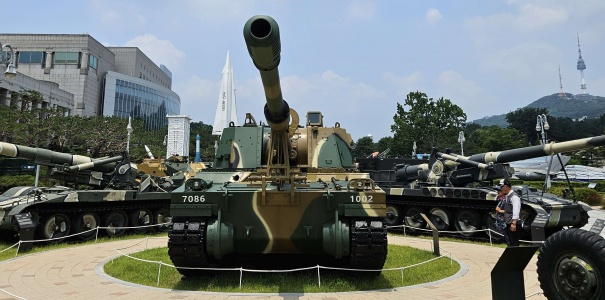Difference between revisions of "VIDAR"
m (changed the pros section to say "Cannot be penetrated by HMGs" instead of "Invunrable against HMGs") (Tag: Visual edit) |
m (Image of the XK-9 added to provide visual aids of the prototype K9) |
||
| Line 170: | Line 170: | ||
== Media == | == Media == | ||
<!-- ''Excellent additions to the article would be video guides, screenshots from the game, and photos.'' --> | <!-- ''Excellent additions to the article would be video guides, screenshots from the game, and photos.'' --> | ||
| − | + | <gallery mode="packed-hover" heights="200"> | |
| + | File:XK-9 Prototype Taken At WMoK 2023-06-24.jpg|<small>XK-9 (The predecessor to the K9/K9A1, produced in 1995 for testing) on display at the War Memorial of Korea</small> | ||
| + | </gallery> | ||
;Skins | ;Skins | ||
Revision as of 00:58, 11 March 2024
Contents
Description
The Versatile InDirect ARtillery is a self-propelled artillery system employed by Norway since 2022. The system is an export version of the South Korean K9 Thunder Self-Propelled Artillery Gun. Norway acquired the system to replace its aging M109A3GNMs of American origin. Norway acquired a total of 24 K9 Thunder artillery systems. The deliveries started in 2019 and concluded in 2021. The system has some differences compared to the South Korean version, like a combined NBC protection and air conditioning situated at the rear of the turret. This system was given to the Artilleribataljonen of the Brigade Nord, the only artillery unit in the Norwegian army.
Introduced in Update "Sons of Attila", the VIDAR is fitted with excellent optics and fire control system. At its BR, it is one of the few vehicles with both thermal imaging system and a laser rangefinder. However, the VIDAR lacks substantial armour. Its best round is a 155 mm HE shell that is capable of destroying most tanks but requires very good aiming when it faces heavily armoured targets like the T-55AMD. The vehicle also has a poor turret rotation speed and no stabilizer, and, being an artillery system, the gun depression is very mediocre. However, it has good mobility for a vehicle of its size, and a very good reverse speed of 42 km/h.
General info
Survivability and armour
The VIDAR is based on ROKA's K9A1 Thunder SPH, although the vehicle can be said as one of the most modern vehicle in-game, the overall survivability is still not for frontline operations due to its nature of a SPH. The purpose of protection for SPH is for stopping close-call shrapnel from injuring the crew, supporting vehicles like such are usually deployed at the rear of battlefield to support the assault forces - this is no exception for VIDAR.
Thanks to the overall improved armor technology, the hardened armor on both the chassis and turret can now make sure even basic 20 mm ammunition (generally used by non-combat SPAA or as auxiliary weapon by some medium tanks) cannot harm the crew from any direction at ranges of 300 m or above, but do not take it as a medallion to go for the frontline - even weakest autocannons can still tear down the vehicle with relative ease through the turret neck or at point blank range.
The SPG is extremely sturdy and will not take overpressure damage unless obliterated by another artillery tank or hit into three very specific weak spots - the belly right above the tracks next to the turret (not going to happen under normal circumstances), the turret ring (while not impossible, might be difficult to hit before VIDAR fires) or the gun breech (only vulnerable to 105+ mm HE and poses risk of the cannon catching the shell), so anyone trying to parry VIDAR with HESH/HE/ATGM thinking "it's just another SPG" is going to have a very bad time. The kinetic shells will easily penetrate, so having a teammate to cover the flank against random snipers is always a good idea to extend VIDAR's service life for as long as possible.
As for the crews, thanks to the long hull and large engine block, shrapnel from enemy shots to the hull might have a hard time to cause lethal damage to the turret crew (but costs the driver); if enemy players are aware of the huge turret, the crew of four can rotate as generally only two of them will be knocked down by the projectile, unless the detonation of up to 48 shells at the rear of the turret happens, in which case there will be huge fireworks as the turret flies hundreds of meters away.
Armour type:
| Armour | Front (Slope angle) | Sides | Rear | Roof |
|---|---|---|---|---|
| Hull | 40 mm | 35 mm Top 35 mm Bottom |
35 mm | 10 - 35 mm |
| Turret | 35 mm Turret front 20 mm Gun mantlet |
35 mm | 35 - 45 mm | 35 mm |
| Cupola | 20 mm | 20 mm | 20 mm | 20 mm |
Notes:
Mobility
| Game Mode | Max Speed (km/h) | Weight (tons) | Engine power (horsepower) | Power-to-weight ratio (hp/ton) | |||
|---|---|---|---|---|---|---|---|
| Forward | Reverse | Stock | Upgraded | Stock | Upgraded | ||
| Arcade | 73 | 44 | 48 | 1,420 | 1,908 | 29.58 | 39.75 |
| Realistic | 68 | 40 | 884 | 1,000 | 18.42 | 20.83 | |
Modifications and economy
Armaments
Main armament
For countering possible enemies, Hyundai WIA developed the domestic 155 mm CN98 L/52 howitzer for K9 Thunder using NATO standard 155 mm ammunition, it is no exception for the export VIDAR for Norway; thanks to its rather fast reload rate (for the first three shells on the "ready-rack") the and varieties of ammunition, CN98 makes VIDAR a fearsome SPH even against "doomsday tank" and early-Cold War tanks, enemy aircraft will also fall victim of it if VT shell is loaded, turning it into a 155 mm anti-aircraft cannon. Do note that the gun does not have an autoloader and upon severe crew loss the reload speed advantage is lost.
| 155 mm CN98 | Turret rotation speed (°/s) | Reloading rate (seconds) | |||||||||||
|---|---|---|---|---|---|---|---|---|---|---|---|---|---|
| Mode | Capacity | Vertical | Horizontal | Stabilizer | Stock | Upgraded | Full | Expert | Aced | Stock | Full | Expert | Aced |
| Arcade | 48 | -4°/+70° | ±180° | N/A | 8.8 | 12.2 | 14.8 | 16.4 | 17.4 | 7.80 | 6.90 | 6.36 | 6.00 |
| Realistic | 5.9 | 7.0 | 8.5 | 9.4 | 10.0 | ||||||||
Ammunition
| Penetration statistics | |||||||
|---|---|---|---|---|---|---|---|
| Ammunition | Type of warhead |
Penetration @ 0° Angle of Attack (mm) | |||||
| 10 m | 100 m | 500 m | 1,000 m | 1,500 m | 2,000 m | ||
| M107 | HE | 61 | 61 | 61 | 61 | 61 | 61 |
| M107 (PF) | HE-VT | 61 | 61 | 61 | 61 | 61 | 61 |
| OE F3 | HE | 61 | 61 | 61 | 61 | 61 | 61 |
| Shell details | ||||||||||||
|---|---|---|---|---|---|---|---|---|---|---|---|---|
| Ammunition | Type of warhead |
Velocity (m/s) |
Projectile mass (kg) |
Fuse delay (m) |
Fuse sensitivity (mm) |
Explosive mass (TNT equivalent) (kg) |
Ricochet | |||||
| 0% | 50% | 100% | ||||||||||
| M107 | HE | 563 | 43.1 | 0.3 | 0.1 | 9.14 | 79° | 80° | 81° | |||
| OE F3 | HE | 935 | 44.4 | 0.3 | 0.1 | 9 | 79° | 80° | 81° | |||
| Proximity-fused shell details | ||||||||||||
|---|---|---|---|---|---|---|---|---|---|---|---|---|
| Ammunition | Type of warhead |
Velocity (m/s) |
Projectile mass (kg) |
Fuse delay (m) |
Fuse sensitivity (mm) |
Arming distance (m) |
Trigger radius (m) |
Explosive mass (TNT equivalent) (kg) |
Ricochet | |||
| 0% | 50% | 100% | ||||||||||
| M107 (PF) | HE-VT | 580 | 43.1 | 0 | 0 | 300 | 3 | 9.14 | 79° | 80° | 81° | |
| Smoke shell characteristics | ||||||
|---|---|---|---|---|---|---|
| Ammunition | Velocity (m/s) |
Projectile mass (kg) |
Screen radius (m) |
Screen deploy time (s) |
Screen hold time (s) |
Explosive mass (TNT equivalent) (g) |
| M110 | 563 | 40.8 | 21 | 5 | 30 | 50 |
Ammo racks
| Full ammo |
Ammo
Type |
1st rack empty |
2nd rack empty |
3rd rack empty |
4th rack empty |
5th rack empty |
Visual discrepancy |
|---|---|---|---|---|---|---|---|
| 48 | Projectiles
Propellants |
34(+14)
31(+17) |
19(+29)
21(+27) |
10(+38)
3(+45) |
3(+45)
1(+47) |
1(+47)
N/A |
Yes |
Machine guns
| 12.7 mm M2HB | ||||
|---|---|---|---|---|
| Mount | Capacity (Belt) | Fire rate | Vertical | Horizontal |
| Pintle | 600 (200) | 575 | -6°/+15° | ±180° |
Usage in battles
VIDAR's CN98 (155mm) cannon can only inflict damage with HE rounds, so players should be at least aware of how Overpressure works in War Thunder. Having some knowledge of where vehicles can be overpressured (turret rooftops, the upper plates of the hull, areas around hull ammunition storages and so on) is the bare minimum to be able to do any consistent damage to enemy vehicles.
The VIDAR can generally consider two types of enemies as its most noteworthy adversaries; vehicles with stabilized guns, which can fire on the move, and enemy APCs, IFVs, and SPAAGs with high-calibre, rapid-firing heavy machine guns or autocannons. While the VIDAR is constructed mainly out of 35 mm hardened steel plates as opposed to the thin aluminium of its older artillery brethren such as the M109s, it still requires smart planning and quick moving to remain intact. Any enemy main gun will make short work of the VIDAR, and the thin plating can only resist HMG and certain autocannon rounds. Most enemy vehicles must therefore be considered lethal; while the vast majority of 12.7 mm (.50 cal) and 14.5 mm HMG rounds can be shrugged off, anything bigger is much more likely to either fully penetrate or at least severely harm the vehicle. Many 20 mm APDS rounds will go through the armour at normal engagement ranges. Any sort of HVAP or APDS bigger than 20 mm will ignore the steel plates; APFSDS will not even think of it as a barrier between itself and the crew or ammunition load! Here, enemy IFVs such as the Bradleys, Type 89, or BMP series can be considered dangerous opponents to face. An enemy missile hitting the VIDAR is more likely than not to destroy the vehicle.
Using the very good acceleration and turning speeds of the VIDAR will help the commander move quickly from one favourable position to another. Using natural cover such as trenches, ditches, muddy riverbanks, or small clusters of trees will help conceal the vehicle while remaining within viewing distance of the battlefield. The excellent sights will provide the opportunity to spot and engage enemies from afar, and the near-instant-use laser rangefinder will automatically raise or lower the gun to the right horizontal elevation for the targeted enemy who finds himself at the receiving end of the L/52 cannon.
The choice of HE-VT means the VIDAR can successfully engage aircraft. Using the laser rangefinder, one can target helicopters at range, both stationary and moving. With some practice, it becomes relatively easy to engage moving aircraft using the high muzzle velocity, good sights, and good proximity fuzing radius. Enemy planes flying directly against the VIDAR can be "swatted" out of the sky with ease.
Pros and cons
Pros:
- Great firepower
- Fast reload rate for a SPH
- Agile and nimble chassis
- Thermal imager and laser rangefinder
- 35 mm average all-around armour
- Can't be overpressured from <120 mm HE
- Cannot be penetrated by HMGs
Cons:
- Weak survivability
- Only partial protection from autocannons
- Poor gun depression
- Relatively small first-stage ammo rack
History
The Versatile InDirect ARtillery is an export version of the South Korean K9 Thunder Self Propelled Artillery System, in service with the Norwegian Army. Norway decided to acquire a total of 24 K9 Thunder systems as well as 6 K10 resupply vehicles to replace their aging American-made M109A3GNM.
The VIDAR is operated by the only artillery unit in the Norwegian Army, the Artilleribataljonen of the Brigade Nord. The vehicle was manufactured by the company Hanwha Land Systems, deliveries started in 2019 and finished between 2020 and 2021. All units were considered operational by the Norwegian Army by January 1st, 2022.
The K9 Thunder was developed by South Korea, inspired by the American M109 Paladin. The vehicle was meant to be compatible with NATO projectiles and have good mobility to counteract counterbattery fire and change positions quickly and safely. The K9's first prototype was unveiled in 1996. The contract for its development was awarded to Samsung Aerospace Industries and just 3 years later in 1999 the ROK Army started to receive its first units of the vehicle. The first nation to acquire the production rights for the system was Turkey.
The K9 has only seen action in the Yeonpyeong bombardment of 2010, an artillery exchange between South Korean and North Korean soldiers. In this incident, 6 K9 systems from the South Korean Marine Infantry opened fire against North Korean positions.
The K9 has received very good export deals. Competing in the international markets with very powerful systems like the American M109 and German Pzh 2000, it has sold more than 1,700 units, including those for South Korea. Turkey has also fitted their own version of the system, the T-155 Firtina, with 300 units expected to be deployed.
Media
- Skins
- Videos
See also
Links to the articles on the War Thunder Wiki that you think will be useful for the reader, for example:
- reference to the series of the vehicles;
- links to approximate analogues of other nations and research trees.
External links
| Sweden tank destroyers | |
|---|---|
| Strv m/41 derivatives | Spj fm/43-44 · Sav m/43 (1944) · Sav m/43 (1946) · Pvkv II · Pvkv III |
| Ikv 72/103 | Ikv 72 · Ikv 103 |
| Pvkv m/43 | Pvkv m/43 (1946) · Pvkv m/43 (1963) |
| ATGM | UDES 33 · Pbv 302 (BILL) · Pvrbv 551 |
| Other | SAV 20.12.48 · Bkan 1C |
| Norway | VIDAR |
| Sweden premium ground vehicles | |
|---|---|
| Light tanks | ▄T-26E · Strv m/39 · Pbil m/40 · Strv m/41 S-I · CV 9035DK · CV 90105 |
| Medium tanks | Sherman III/IV · Strv 81 (RB 52) · Strv 103-0 · Leopard 1A5NO2 · Christian II |
| Heavy tanks | ▄KV-1 m1942 · Kungstiger |
| Tank destroyers | Ikv 73 · SAV 20.12.48 · VIDAR |






